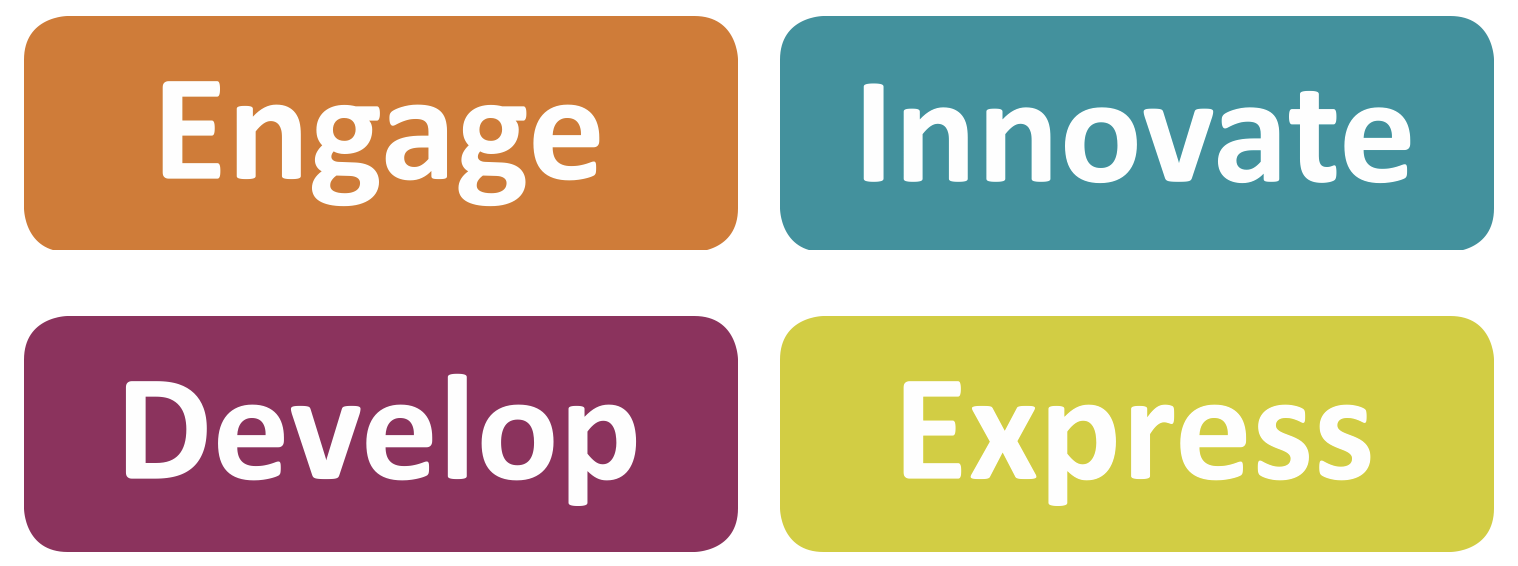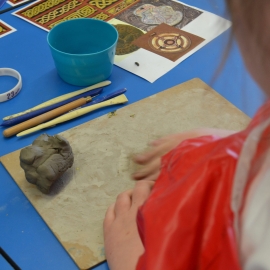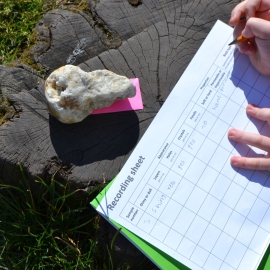Cornerstones Curriculum
Bloxwich Academy Primary
Here at the academy we will be providing a broad and balanced curriculum based around the Cornerstones Curriculum, a nationally recognised approach for delivering outstanding learning opportunities for children.
What is the Cornerstones Curriculum?
The Cornerstones Curriculum is a creative and thematic approach to learning that is mapped to the 2014 primary national curriculum to ensure comprehensive coverage of national expectations. It is based on a child-centred pedagogy called The Four Cornerstones and is delivered through Imaginative Learning Projects (ILPs) and Knowledge Rich Projects (KRPs), which provide a rich menu of exciting and motivating learning activities that make creative links between all aspects of children’s learning. We believe children learn better when they are encouraged to use their imagination and apply their learning to engaging contexts. Our curriculum provides many learning challenges throughout the academic year that require children to solve problems, apply themselves creatively and express their knowledge and understanding effectively. Cornerstones also provide a rigorous skills and knowledge framework that outlines the end of year expectations in all subjects. These skills and knowledge are tied to activities and are age-related so that staff can track children’s progress and identify their individual learning needs.
These are the following ILPs/KLPs that each Year group will be covering, each one will start with a ‘memorable experience’.

Nursery: Can I have a dog?
How do I look after it? Children will explore these questions and more in this project about pets and how to care for them.
Reception: Do cows drink milk?
What are baby pigs called? Children will explore these questions and more in this project about life on the farm and the animals that live there.
Year 1: Childhood
This project teaches children about everyday life and families today, including comparisons with childhood in the 1950s, using artefacts, toys and a range of different sources. Children will compare their own experiences to those of children from the 1950’s.
Year 2: Scented garden
Children will take part in some amazing activities linked to gardening and will be creating a delicious herb garden for everyone to enjoy. They will also explore the sensory world of plants and the environment developing their knowledge of the five senses, how plants grow, and how we can use them in everyday life.
Year 3: Rocks, relics and rumbles
This project teaches children about the features and characteristics of Earth's layers, including a detailed exploration of volcanic and tectonic activity. They will learn about different types of rocks and we will be looking at world maps, locating where volcanoes are and where earthquakes have happened around the world.
Year 4: Traders and raiders
This project will develop children’s knowledge of Britain’s early invaders and settlers. Children learn about Anglo-Saxon and Viking culture, chronology and key events. The children will be looking at the collapse of the Roman Empire in Britain, and how the Anglo-Saxons stood up against the Vikings. Children will also be using their geographical knowledge to help them with locating famous Saxon sites around the UK.
Year 5: Sow, grow and farm
This project teaches children about the features and characteristics of land use in agricultural regions across the world, including a detailed exploration of significant environmental areas. The children will become gardeners with a passion for growing and encouraging the environment, and will learn about sustainability and the way in which all different manner of food is grown and harvested. The children will also discuss food miles and where food comes from across the world.
Year 6: Revolution
Children will be taught about life in Victorian times developing their knowledge about Victorian culture, including significant people and inventions of the time. Children will explore and sample life in the Victorian times and much more!
Help your child prepare for their project.
How much is that doggy in the window? Can I have a dog? How will I look after it? It’s time to find out all about pets and how to care for them.
This half term, look at local pet store to learn about animal care. We’ll see small animals and ask lots of questions. Back at school, we’ll rear and look after some chicks. Our role play vets surgery will keep us busy, as we’ll bathe, bandage and feed toy animals. Using our problem-solving skills, we’ll sort pet care items using different criteria. Getting creative, we’ll use stencils to create animal prints. In our literacy work, we’ll share books, reading animal names and exploring the initial sounds. We’ll take a walk on the wild side when we practise moving like animals. Will we curl up like a cat or run like a dog? Inspired by pictures of amazing animals, we’ll draw the pet we would like and write its name. Using our maths skills, we’ll count the dogs in different sets.
At the end of the project, we’ll make a collaborative scrapbook and share stories about our pets.
Help your child prepare for their project.
Let’s learn about pets! Why not use natural materials to make a ‘big art’ pet picture in the garden? Don’t forget to take a photograph! You could also visit a friend or family member to find out how they look after their pet. You might even be allowed to hold it! Alternatively, play ‘pet shops’ using toy animals, taking it in turns to buy them using coins.
Old Macdonald had a farm, e-i-e-i-o! Do cows drink milk? What are baby pigs called? It’s time to find out more about life on the farm and the animals that live there.
This half term, we’ll be looking at local farms to take in the sights, sounds and smells. We’ll observe the different farm animals, crops and vehicles, and maybe explore what it is like to ride in on a tractor! Back in the classroom, we’ll monitor beans as they grow, noting how they change. In our literacy lessons, we’ll make predictions about stories and try out some farmyard rhymes. We’ll create songs about the farm to sing as we shake our homemade seed shakers in time. In our mathematics lessons, we’ll use an animal ‘baa chart’ to estimate the number of popular farmyard animals, and we’ll use addition and subtraction to help Little Bo Beep count her sheep. Outside once more, we’ll take it in turns to be sheepdogs, sheep and farmers. Can we herd all of our sheep into the pen? Getting creative, we’ll use coloured play dough and clay to create farmyard scenarios, and ‘paint’ farm animals using graphics software. Then, we’ll design and make delicious, flavoured breads to sell in our very own farm shop!
At the end of the project, we’ll invite you into school to share our best bits. We’ll write funny farmyard stories and compile a letter to send to the farm we visited, explaining what we’ve learned.
Help your child prepare for their project.
Farms are fantastic! Why not explore your kitchen cupboards together and talk about where different foods come from? Do you have any local farm produce? You could also visit a local farm or petting zoo and take pictures of each animal to share with the class. Alternatively, take toy tractors, spades and trowels outside to dig together in the mud. Add water to the soil for extra muddiness – don’t forget your wellies!
In the Childhood project, your child will learn words and phrases related to the passage of time. They will explore artefacts and toys to help them to understand childhood in the past and how childhood has changed over time. They will explore the six stages of life and explore timelines and family trees. Everyday life in the 1950s will be explored, including shopping, transport, family life and childhood. They will also learn about the significance of Queen Elizabeth II's coronation in 1953 by studying photographs and online sources. The children will use maps to explore how places have changed over time and highlight any similarities or differences between childhood today and childhood in the 1950s. At the end of the project, they will create knowledge organisers for children who are about to study the topic of childhood.
Let’s tiptoe through the tulips together and discover the sights, sounds and smells of the garden.
This half term, we’ll recreate a florist’s shop and a garden centre as a roleplay area. We’ll find out how to look after plants, ask the experts questions and appreciate the flowers. We’ll write a recount about our experiences, follow instructions, enjoy the story of Superworm and write stories of our own. Discovering our green fingers will be fun when we plant and tend a pizza garden of herbs. We’ll also learn about the different parts of a plant and create our own ‘planting and growing’ action rhyme. Our senses will help us describe and sort a range of smells and we’ll make beautifully scented products. We’ll look closely at a wide variety of plants, create detailed, observational drawings and press real flowers to use in collages.
At the end of our project, we will have become plant experts! We’ll create a presentation about plants, share the information books that we have made and design a fantasy garden.
Help your child prepare for their project.
Gardens are so special and are an excellent place to visit together. Why not take close-up photographs of flowers and use a plant identification app or spotting guide to find the name of each plant? You could also buy some wildflower seeds and watch them grow. Alternatively, bake recipes containing fragrant herbs and spices! Cheese and chive scones, cinnamon biscuits and lavender cake are all delicious!
Who’s that waving axes and brandishing swords? It’s the Saxons invading Britain’s shores!
During this half term, we’ll start by making sturdy boats to sail the ocean’s fearsome waves. We’ll write diary entries as an Anglo-Saxon who witnessed the Vikings’ landing, and we’ll find out about key dates. Using Ordnance maps, we’ll plot the location of Roman shore forts and draw our own sketch maps. We’ll make models of Saxon jewellery and carefully carve runes using clay tools. We will be creating exciting non-chronological reports to explain who the Vikings were and what they wanted. Using maps, we’ll identify the places where the invaders came from and locate Viking invasion sites. We’ll also be researching Viking beliefs including all the gods they believed in.
At the end of the project, we’ll reflect on what it would have been like to be a child during these troubled times, and we will be hosting an in-school Anglo-Saxon market. This is where we will be trading the items we have made throughout the project with our classmates.
Help your child prepare for their project.
Watch out – the Saxons and Vikings are invading! Why not research online together to see if there have been any Saxon or Viking invasions in your area? You could also find out more by visiting museum websites to explore Saxon and Viking connections further. Alternatively, read books and watch films together to gain an insight into this period, such as How to Train Your Dragon.
In the Sow, Grow and Farm project, your child will learn about allotments in the United Kingdom and how the government encouraged people to have them to support food rationing during the Second World War (Dig for Victory). They will investigate the different ways that plants reproduce and how this affects the way that farmers plant their crops. They will have the opportunity to learn about farming in the United Kingdom and the techniques used in modern farming and discuss the challenges that farmers face. In writing, the children will explore how one problem involving the climate can affect the way that livestock is cared for the everyday impacts on farmers. They will learn about when different foods and in seasons and the benefits of eating seasonally, as well as the pros and cons of importing food. They will also learn about world farming and how the different climate zones affect where different foods can be grown.
Let’s hop on a steam train and travel back in time to the Victorian era!
During this half term, we’ll use non-fiction books to research Victorian education and people, including famous inventors, reformers and Queen Victoria herself. Then, we’ll write a diary entry and a newspaper using a range of source materials. We’ll write on slates, learn the three ‘Rs’ and take part in cooking, sewing and woodwork lessons, just like a child in a Victorian school. We’ll learn about crime and punishment and what games the Victorian children would have played with. ‘Drill’ activities will have us following instructions to march, stretch and jump in formation. We’ll learn all about the Industrial Revolution and find out what life was like in a Victorian slum. How things have changed! Copying the style of famous Victorian paintings, we’ll experiment with block printing techniques.
At the end of the ILP, we’ll stage an exhibition to showcase the work we have done during the project.
Help your child prepare for their project.
The Victorian era influenced the way we live now in many ways. Why not visit a local museum to learn about what Victorians’ lives were like in your area? You could also visit the library to find out about local Victorian history. Alternatively, make a collage timeline of key events in the Victorian period.





